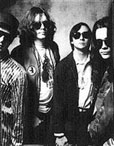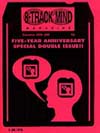It was one of those crisp February days, after the first ice had come and thawed, and us two guys were in my Honda with the bent weather strip cruising northeast toward Lancaster, Pennsylvania. We were talking about the Internet, bad movies, and Malcolm’s band, Gumball. We ate pretzels, guzzled Pepsi, and saw what we could passing by the Harley Davidson plant outside Lancaster. The York Barbell factory wasn’t far off, with its huge rotating strongman on the roof..
Malcolm and I were on the way to see something bigger than any cast iron carnival act. Waiting for us in Lancaster, piled chest-high in an abandoned candy factory, was a mountain of 25,000 infinitely looping, colorfully packaged, plastic-shelled, cheese-o-riffic 8-track tapes.
I didn’t realize it at the time, but I would never see music in quite the same way. The pile of 8-tracks would teach me invaluable lessons about my humanity, about the loops we find ourselves stuck in, about how no matter how far we wander, no matter how much we change, no matter how desperately we push and punch the shrink-wrap we call our daily lives, we always return home like a magnetic tape hissing and kerchunking inside the walls of a dead musical format.
Don’t worry. I’m just kidding.
The 8-track mountain is stored in a practice space rented by Gumball, which is Malcolm from Takoma Park, Don from New York, Jay from Harrisburg and Eric from Pittsburgh. They gathered here to prepare their album Super Tasty. They wanted to promo it on 8-track, just as Rage Against the Machine had done, but Gumball’s label gave them the choice between that or vinyl. They chose vinyl.
Malcolm and Don and Jay were longtime members of the Velvet Monkeys, a D.C. band from the ’80s who put out a few records but no 8-tracks. The guys in Gumball are devoted to LPs, with 8-tracks as a sideshow collection that until July 23, 1993, consisted of a few thousand 5.25-by-4-inch titles stacked on metal shelves.

I have to say, I’ve seen a lot of sights: babies born, dead bodies, sunsets, dwarfs, UFOs. But I have never seen anything like the 25,000 8-tracks heaped in the band’s practice space. Malcolm climbed the mountain so I could snap a photo for scale, and he stumbled and sent tapes tumbling like stones to my feet. He examined a case here and there, as if picking wildflowers.
The 8-tracks came from a junk store, Porter’s Furniture, which is a couple of right turns on the way out of town. Porter’s kid did the deal. The band was scouring for tapes one Friday and disappointed by the selection and prices (Porter charges a buck apiece, which is no garage sale). Shorty, the guy who scurries the wobbly tables, gummy typewriters, locked trunks, pink mattresses and thousands of other items between floors, mumbled something about 8-tracks. Shorty mumbled a lot. Then Mr. Porter came by. He eyed the band suspiciously. “You guys lookin’ for 8-tracks?” he said. “I got 8-tracks.”
He led the musicians to a garage and pulled the doors wide. There, stacked on shelves and in wooden cabinets and cardboard boxes and garbage bags, were more 8-tracks than the children had seen in their whole lives!
The boys offered Porter $100 for 1000 of their choosing. The old man shook his head. He had stored these tapes for come near a decade, and he wasn’t about to let some rockers mine for gold. But the kid, Porter Jr., said “You can have ’em all for $450,” and that was that. Malcolm threw in $125, Jay the same, and Don $200.
They put on work gloves and began scooping up 20 tapes at a time, held like an accordion at full bellow, and dumping them into garbage bags. They borrowed a pick-up and drove to the candy factory and hauled the bags up in the freight elevator. They worked four or five hours a day. It took four days.
Eight-tracks, needless to say, are no longer state-of-the-art. If you remember when they were, you also are no longer state-of-the-art. The reason Malcolm and Gumball enjoy 8-tracks isn’t the sound. They like 8-tracks because of the bootlegs, rarities and obscure artists that have never appeared in any other format. (Malcolm calls the collection “a musical Bermuda Triangle.”) They like them because you get a lot of music for a dime or a quarter, and 8-track players, of which they have 30, can be had for $5 to $30. Sometimes people will give them away, if you can believe that.
Gumball tried to tame the 8-track mountain but gave up. Along one of the walls is the skeleton of a filing system, short stacks of tracks, A through Z. Beyond that, in a corner listening pad (a scrap of yard sale carpet flattens the acoustics) sit boxes of bootlegs, “an amazing amount” of jazz, a few homemades. Those are Malcolm’s favorites. “It’s a time capsule,” he says, holding up a tape with a handwritten playlist of Linda Ronstadt songs.
There is no Beatles in the bunch, no Zeppelin or Mozart. This is Grade B material, so far, although they haven’t reached the bottom of the pile. Many of what they have sorted are duplicates. What can you do with 103 copies of a record by the Andrea True Connection? (Andrea True was a porn star who became a disco singer, and that’s interesting, but her music is not.) There’s Captain and Tennile, and Tammy Faye Bakker singing corny gospel, nearly the entire Misty Label catalog with selections such as “Feelin’ Groovy” by the Rock Revival, and albums by Kiss and Journey.

There are tribute albums such as Malcolm’s prized “Excerpts from the Rock Opera Tommy by ‘The Who’, Vol. 2” with the disclaimer that the album is actually “played by the Decibels.” Other 8-track bands would take names like “Rubber Soul” (after the Beatles’ album) or “The King” (Elvis) to prod buyers into thinking they were karmically in possession of the real thing.
There is some Grade A stuff: Miles Davis, Roxy Music, King Crimson, Sun Ra, Charlie Parker, Jethro Tull, Captain Beefheart. Malcolm considers any tape offered in quadraphonic a prize. These tapes might have been mixed, say, with the drums in speaker one, the guitar in speaker two, the bass in speaker three, and the organ in speaker four. Malcolm once found Emerson Lake and Palmer’s first album in Quad while exploring the mountain, but he set it down and hasn’t been able to find it again.
A week after the band bought the trove, the boys were looking through Goldmine (a newspaper for record collectors) when Malcolm spotted an ad. “25,000 8-tracks. All Styles. All Sealed. Asking $450. Lancaster, PA.” When Malcolm called the number in the ad, Porter didn’t answer. Someone named Keith did, and he couldn’t believe the boys also had 25,000 8-tracks.
“50,000 8-tracks in Lancaster, Pennsylvania!” Malcolm exclaimed. They’d located the 8-track center of the universe.
They still produce 8-tracks, country and western mostly, for truckers. The last plant is located in Nashville. Malcolm snapped open an Engelburt Humperdink to show me the guts. There’s a 300-foot loop of magnetic tape which winds infinitely back onto itself and plays up to 80 minutes of analog sound. It feeds from the inside of the roll, passes over a pinch roller and capstan and tape head openings and under two pressure pads, and then wraps itself back around the outside of the roll. Four programs of stereo are recorded on each tape — 4×2=8 — hence the name 8-track. The signature ker-CHUNK! sound the player makes at the end of each program is the noise of the tape head disengaging from a program and engaging the next.
The inventor of the 8-track was John Lear of Learjet. He registered his patent in 1945, but his break came 20 years later when he convinced Ford to offer in-dash players as an option for their 1966 models. Until then, the cutting edge had been FM radio. Once RCA Victor and Capitol began releasing their catalogs on 8-track, Chrysler and General Motors joined the fray. The carmakers would usually toss in a corny sampler of rock, classical and jazz to whet appetites.
The 8-track’s heyday ended around 1971, when the first auto-reverse cassette decks appeared. The boxy 8-tracks were a pain, with all the hissing and jamming, and they still are for those who keep the dream alive. If you’re not careful, the rubber roller can melt from the friction, spewing a tarry substance that destroys the 8-track and clogs your player.
Radio Shack hasn’t offered an 8-track player since its 1990 catalog, when item number 14-935 went for $9.95. You may find blank tapes or head cleaners at some Radio Shacks — the ones nobody visits — but officially the company doesn’t stock them. Mail-order record clubs offered the format until as late as 1988. A few devoted trackers cross out “compact discs” on the club’s postage-paid membership cards and mail them back with “8-tracks” scribbled across the top. The clubs reply with form letters.
There are three 8-tracks that get you invited to the ball. The first is Lou Reed’s Metal Machine Music, which Lou claimed he made to satisfy the record deal he wanted out of. Malcolm calls it “the Holy Grail of 8-tracks.” Don has a copy and got Lou to sign it. So Don gets an invitation.
The second tape is The Yardbirds Live with Jimmy Page (with its smoking version of “Dazed and Confused” called “I’m Confused”). The third tape is the Sex Pistols’ Never Mind the Bullocks. A copy recently sold for $100 at a Dallas record store, which caused a gnashing of teeth among trackers. The store owner, Mr. Bucks, said he had put the $100 tag on Bullocks because he didn’t want it to sell. One day some kid came in while Bucks was at lunch. He didn’t even try to bargain the clerk down.

This transaction set off a panic among the readers of 8-Track Mind, the quarterly bible of the tracker community edited by Russ Forster. Collectors worried that the high-end sales of Bullocks might drive 8-track tapes beyond the $1 to $5 price for premium titles. When Malcolm wrote to tell Forster about the band’s 25,000 tapes, his response was “My head is spinning.”
Forster, who owns 500 8-tracks, is shooting a film on trackers and life. He hopes the film will “dispel the notion that people into 8-tracks are beer-bellied ex-hippies trying to relive their glory days.” His 100 or so subscribers, he says, are generally white, middle-aged and educated.
Russ notes that the Chicago band Big Black has a compact disc called The Rich Man’s 8-Track Tape. “That hits it on the head,” he says.
On our way out of Lancaster, Malcolm and I stopped at Porter’s. Just inside the door, we admired a liquor cabinet / miniature bar / 8-track system unit, priced not to sell at $375. The cabinet had a serving rack for eight shot glasses, and a fireplace with a plastic log facade and a rotating orange light to stimulate heat. Endless drinks, infinitely looping music, a fire that never goes out — it summed up an entire decade.
Then, abruptly, Malcolm’s eyes widened. Next to the cabinet sat a box of shrink-wrapped 8-tracks.
“They held some back,” he said, picking up a copy of Funkadelics’ One Nation Under a Groove. Malcolm had a flash of fire in his eyes. But he caught himself, and his shoulders fell, and he flipped the tape back into the box. Soon Malcolm — and Gumball — will be the undisputed 8-track kings of the world, and no piddly puddle of tracks in a junk store in the middle of Pennsylvania would be able to topple them.
From Washington City Paper, March 1994